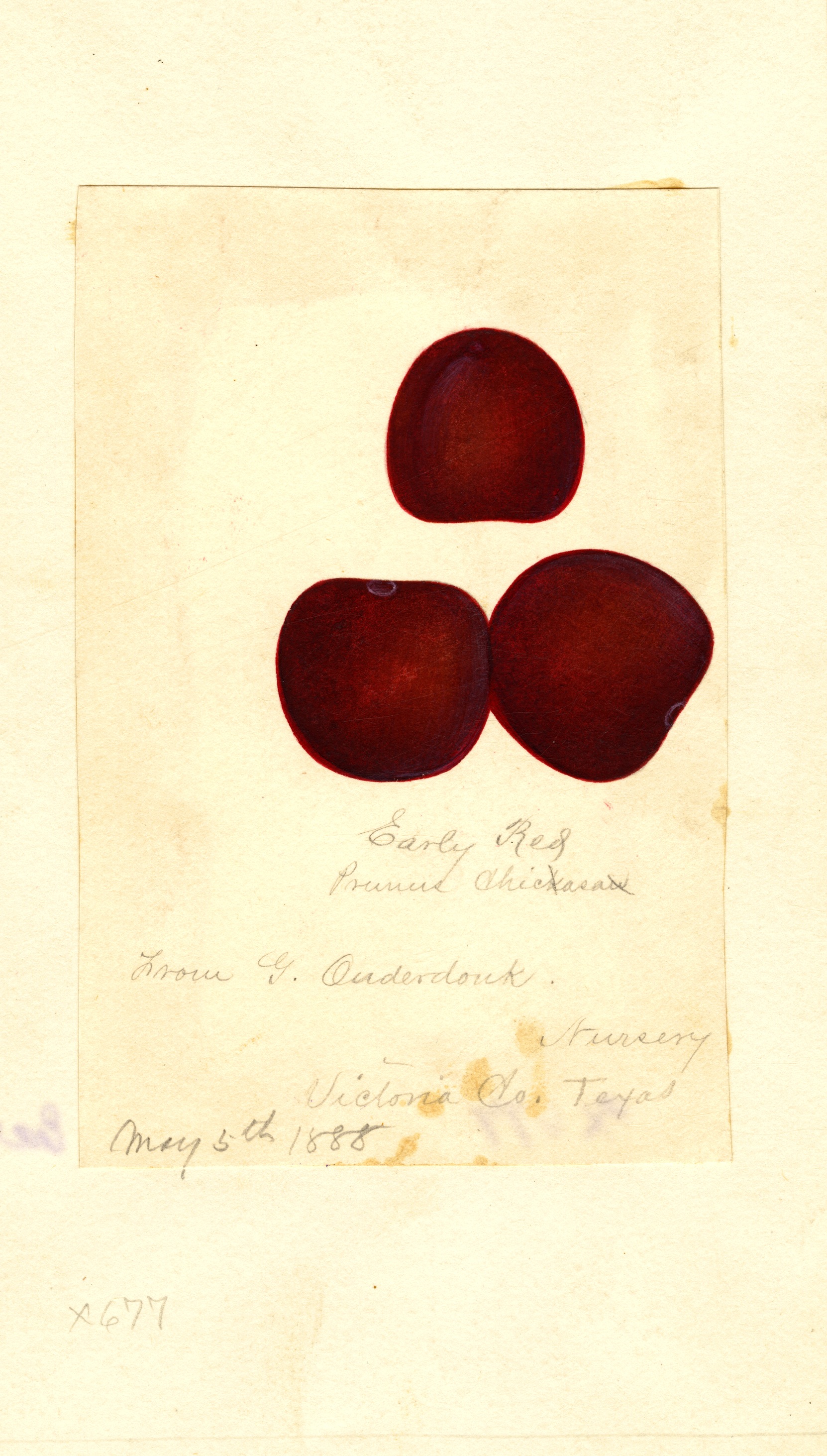
CHICKASAW PLUM (Prunus augustafolia)
One of the few fruits native to North America, the Chickasaw (or Sandhills) Plum originally grew in central Texas and Oklahoma, but Native cultivators spread it eastward to the Atlantic and westward to New Mexico. Growing on a shrubby tree six to nine feet tall, the egg-shaped wild fruits of yellow, orange, or red swell to a maximum of half inch in breadth, nestled in spikey, thickly branched nets of red-brown twigs. The toothed leaves look like narrow lance-like peach leave. Trees tend to cluster in stands, colonizing niches or ridges on a landscape, and these stands become havens for birds, wildlife, and domestic livestock on the range. In Spring the white blossoms cluster spectacularly, then give way to the fruit. Isolated trees can grow to 25 feet in height. Native communities ate the acidic fruit fresh, dried it, mashed the meat of the fruit together with nuts, and boiled it—though the flavor quality can vary markedly in wild strains, from sharply bitter to pleasantly sweet. European settlers tended to mingle it with sugar in jelly and preserves, or made it into wine, with sugar being the engine to make the alcohol. Presently it is enjoying a vogue as an indigenous edible landscape plant.
Beginning in the middle of the 19th century nurserymen began cultivating and improving America’s wild plums—the Wild Goose Plum (Prunus munsoniana), the American Wild Plum (Prunus americana) and the Chickasaws, tending to lump them all in the category of Chickasaw Plum despite their botanical differences. P. J. Berkmanns of Augusta had collected wild varieties and began improving them in the late 1860s. [“Chickasaw Plum,” Prarie Farmer 45, 7 (February 14, 1874), 50.] But the first nursery releases took place in Louisiana with an intensely red strain named Caddo Chief by G. W. Stoner. [Illustration #2 below] It would enjoy particular popularity in Texas and Louisiana, with Clingman Orchards of Kiethville LA and Comol Spring Nursery in Dallas embracing the strain. Relatively disease free when compared to European and Japanese plums, the native Chickasaws were used as stocks upon which foreign varieties were grafted. But the low maintenance recommended them as a fruit source in themselves and it was a rare southern nursery that didn’t include three or more native plums under the heading of “Chickasaw Plums” for its customers. The particular virtues of these plums were: “a very hard, firm flesh, even up to and after coloring, so as to furnish no congenial resting place for the curculio [the insect that was the bane of plum and apricot growers]; for the same reason a great exemption from the destructive rots that sweep off our common garden plums, in hot, humid weather, and they can be house-ripened or ripened in the package while going to market.” [“Chickasaw Plum,” Prarie Farmer 45, 7 (February 14, 1874), 50.]
Texas is now the hotbed of experiments in Chickasaw Plum wine. The iridescent jelly has been a home favorite for 140s years throughout the South.
Chickasaw Plum—the improved varieties were selected for size of the drupes, with individual nurserymen assigning names to the strains they developed. A second interest was fruit color, with some breeders choosing for yellow skinned drupes and naming the results Golden Beauty or Cumberland (Berkmann’s improvement of seed found in 1864). This latter would also be called Yellow Cherokee Plum. Indeed the names and strains multiplied with as many as 40 forwarded to the American Pomological Society before 1920. In 1915 William Franklin Wright in the USDA Bulletin 172, The Varieties of Plums Derived from Native American Species noted the following as strains of Prunus augustafolia: African, Black African, Clark, Cluck, Coletta, Denton, Early Honey, Early Sweet, Echo, Emerson, Everbearing, Fawn, Goden Drop, Hattie Porter, Heep, Heming, Hendrick, Jennie Lucas, Lindheimer, Lone Star, Mason, McCartney, Munson, Piram, Red Chickasaw, Sanders, Waddell, Yellow Cherokee, Yellow Transparent.
http://oikostreecrops.com/products/chickasaw-plum/
http://www.saundersbrothers.com/index.cfm/fuseaction/home.contact/index.htm
David S. Shields